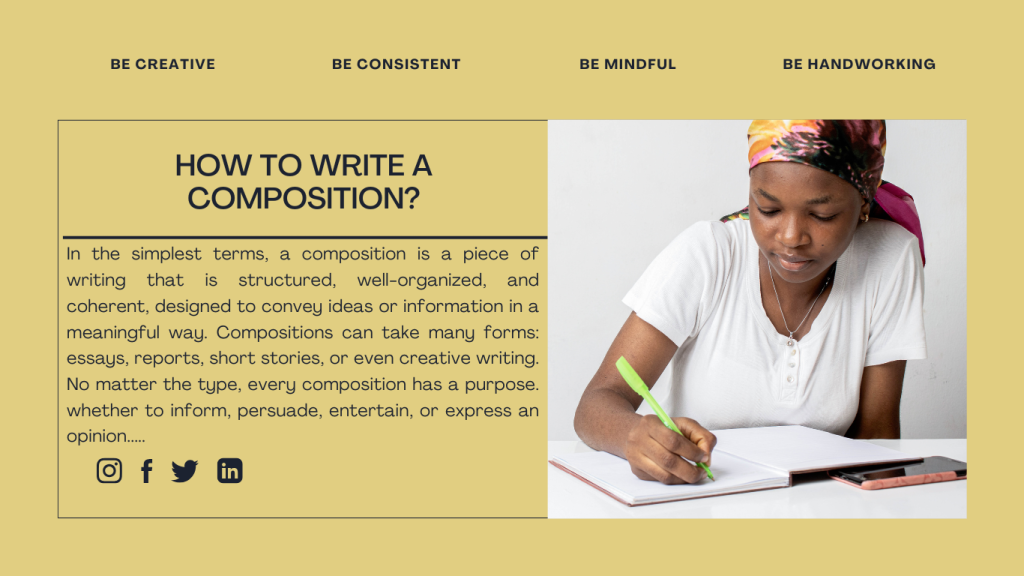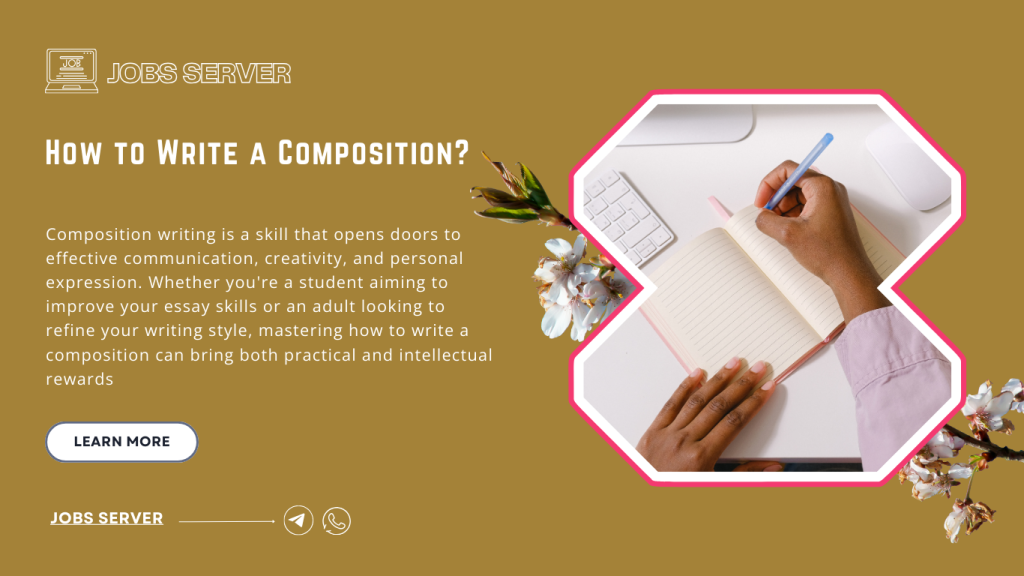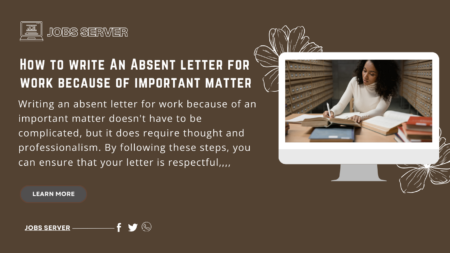How to Write a Composition?
INTRODUCTION
Composition writing is a skill that opens doors to effective communication, creativity, and personal expression. Whether you’re a student aiming to improve your essay skills or an adult looking to refine your writing style, mastering how to write a composition can bring both practical and intellectual rewards. In this Article, we’ll dive deep into what composition writing entails, its essential structure, and a step-by-step approach that will make your writing process smoother, more engaging, and unique. We’ll also explore the advantages and disadvantages, so you can be fully equipped to write a composition that shines.
WHAT IS A COMPOSITION?
Before jumping into the writing process, let’s clarify a composition. In the simplest terms, a composition is a piece of writing that is structured, well-organized, and coherent, designed to convey ideas or information meaningfully. Compositions can take many forms: essays, reports, short stories, or even creative writing. No matter the type, every composition has a purpose. whether to inform, persuade, entertain, or express an opinion. Understanding what a composition is and how it’s built is the first step toward mastering this essential skill.
WHY LEARNING TO WRITE A COMPOSITION IS GOOD
Learning how to write a composition is a crucial skill that extends beyond academic needs. In every area of life. whether in school, in your job, or personal relationships. the ability to convey ideas clearly can set you apart. Effective composition skills make you a better communicator, enable you to present your thoughts with clarity, and can even give you an edge in professional environments. Once I understood how useful composition writing could be, I noticed that I could convey complex thoughts in an organized, understandable way, whether I was writing a report for school or drafting a message to a friend.
IMPORTANCE OF STRUCTURE IN WRITING A COMPOSITION
Structure is one of the most critical elements of composition writing. Imagine reading a story without any logical flow or trying to follow instructions that jump around randomly. it’s confusing and frustrating! A well-structured composition, on the other hand, guides readers smoothly from one idea to the next, making it easier to understand and follow. The standard structure includes an introduction, body paragraphs, and a conclusion. Understanding this layout is essential, but equally important is learning how to make it engaging.
When I was learning to write compositions in school, I struggled with organizing my thoughts. I would jump from one idea to another, and the result was a messy, confusing essay. My teacher advised me to create a basic outline before I started writing, which was a game-changer. Outlining not only helped me structure my thoughts but also made writing far less overwhelming.

STEP-BY-STEP ON HOW TO WRITE A COMPOSITION
Let’s break down the composition-writing process into manageable steps. This step-by-step guide will help you approach your writing with confidence and precision.
Step 1: Choose a Topic and Know Your Purpose
Selecting a topic might seem straightforward, but it’s more nuanced than it appears. The topic should align with the purpose of your composition—whether it’s to inform, persuade, or entertain. If you’re free to choose, think about topics that interest you or spark curiosity. It’s much easier to write a composition about something you’re genuinely engaged with.
I remember when I had to write a composition on “The Importance of Recycling” in school. Initially, I thought it was too broad, so I narrowed it down to focus on “How Recycling Can Make a Difference in Local Communities.” This made it more specific and relatable, and I found it much easier to write because I could connect it to my neighborhood’s recycling program.
Step 2: Brainstorm and Research Ideas
After choosing a topic, jot down any ideas that come to mind. This is your brainstorming stage, so don’t worry about organization yet. just let the ideas flow. Also, conduct some research if necessary to gather facts, quotes, or data that will make your composition more compelling.
- ALSO CHECK
- Step By Step On How To Write A Resignation Letter From Work.
- Step By Step On How To Write An Absent Letter For Work Because Of Important Matter.
- Step By Step On How To Write An Application Letter For A Hotel Job
- Step By Step On How To Write A Business Proposal For Funding
- Step By Step On How To Write An Argumentative Essay
Outlining is a powerful tool that saves time and improves clarity. Create a simple outline that includes your introduction, body points, and conclusion. This structure will act as a roadmap for your composition, making the actual writing process much more straightforward.
- Introduction: Outline how you will introduce the topic and engage readers.
- Body Paragraphs: Identify the main points you want to make and any supporting details for each.
- Conclusion: Plan how you’ll wrap up your composition with a summary or a call to action.
Tip: For me personally, I often break down each body paragraph by listing three main points I want to cover, which keeps me from rambling or going off-topic.
Step 4: Write the Introduction
Your introduction is the hook that draws readers in. Start with a statement, question, or fact that grabs attention. Next, provide a brief background on the topic and state the purpose of your composition. The introduction should make readers curious and set the stage for what’s to come.
Step 5: Develop the Body of the Composition
The body is where you dive into the details. Each paragraph should introduce a single main idea and follow up with supporting information or examples. Keep paragraphs clear and concise, with smooth transitions between ideas.
When writing about recycling, I structured the body paragraphs to cover different aspects. why recycling is beneficial, how local programs work, and ways individuals can contribute. This division kept each point focused and the entire composition easy to follow.
Step 6: Conclude Your Composition
The conclusion is your final opportunity to leave an impression on readers. Summarize the main points without repeating them verbatim, then end with a statement that reinforces the composition’s purpose or encourages readers to think more deeply about the topic.
Step 7: Edit and Proofread
Good writing is all about revision. Once you’ve completed your draft, take a break, then come back with fresh eyes to review for grammar, spelling, and clarity. Sometimes, reading your composition aloud can help you catch awkward phrasing or misplaced ideas.
ADVANTAGES AND DISADVANTAGES OF COMPOSITION WRITING
Advantages
- It Improved Communication Skills: Composition writing helps articulate thoughts more effectively, benefiting personal and professional interactions.
- It Enhanced Creativity: Writing compositions, especially in a creative format, stimulates imagination and cultivates new ideas.
- It Helps In Academic And Professional Growth: The ability to write clearly and persuasively can boost academic performance and is an asset in many careers.
- It Helps In Intellectual Growth: Writing encourages critical thinking and deeper exploration of topics.
- Sense of Achievement: Completing a well-structured composition brings a sense of satisfaction and pride.
When I improved my composition skills, I noticed an overall boost in confidence. I felt more competent in both my school assignments and everyday writing tasks.
Disadvantages
- Its Time-Consuming: Writing and revising a good composition requires significant time, which can be challenging for people with busy schedules.
- Writer’s Block: Occasionally, finding the right words or ideas can be difficult, leading to frustration.
- Editing Fatigue: Reviewing one’s own work critically can be tiring, especially for lengthy compositions.
- Risk of Plagiarism: If not careful, writers may unintentionally replicate phrases or ideas, which can harm their credibility.
- Difficulties with Structure: Organizing ideas coherently is challenging, especially for beginners who might find it hard to maintain focus.
FINAL THOUGHTS
Mastering how to write a composition is a rewarding journey. From school assignments to work reports, composition writing can enhance your communication skills and open doors to new opportunities. By following the structured steps outlined here and taking advantage of the composition process, you can make your writing clearer, more engaging, and uniquely yours. Remember to practice regularly, stay patient with yourself, and enjoy the creative process. Whether you’re writing to inform, persuade, or entertain, every composition is an opportunity to share your perspective with the world.
SOME ASKED QUESTIONS ON HOW TO WRITE A COMPOSITION.
- What is the first step in writing a composition?
The first step is selecting a topic and defining your purpose. Think about why you’re writing and who your audience is. This focus will guide your content and structure, setting a strong foundation for your composition.
- How can I make my composition more interesting?
Use vivid examples, relatable anecdotes, or thought-provoking questions to engage readers. A personal story or unexpected fact can hook attention and make your composition stand out from others.
- Why is an outline important in composition writing?
An outline organizes your ideas and keeps your writing focused. It acts like a roadmap, helping you stay on track and ensuring each point flows logically to the next. Outlining saves time and reduces writer’s block.
- How can I improve the structure of my composition?
Stick to the classic format: introduction, body, and conclusion. Each section should serve a specific purpose—introduce, expand, and summarize. This structure helps readers follow your ideas smoothly.
- What makes a good introduction for a composition?
A great introduction grabs attention, sets up the topic, and hints at what’s to come. Try starting with a question, a surprising fact, or a bold statement that piques curiosity and pulls readers in.
- How do I avoid common mistakes in composition writing?
Proofreading is key. Read your work aloud to catch awkward phrasing, and don’t rely solely on spell check—look for structure issues, unclear sentences, or repetitive ideas that might weaken your writing.
- Why is the conclusion important in a composition?
The conclusion wraps up your main points and leaves a lasting impression. A strong closing helps readers remember your key message and gives a sense of completeness to your composition.
- How can I make my composition unique?
Add a personal touch. share your insights, experiences, or examples. Readers appreciate an authentic voice, and it helps make your writing original and memorable.
- How do I stay within the word limit for a composition?
Focus on your main points and be concise. Avoid repeating ideas or adding unnecessary filler. A clear outline helps you stay focused, so you only include what’s essential.
- What are the best ways to revise a composition?
Take a break, then review with fresh eyes. Start by checking the flow and clarity of your ideas, then tackle grammar and spelling errors. Editing in stages helps produce a polished final draft.
- How can I write a composition faster?
Use a timer and set mini-deadlines for each section. Outline your main points first, then draft without overthinking. Focusing on speed during the first draft allows you to edit and refine later.
- Why do I struggle with ideas for my composition?
Sometimes, overthinking blocks creativity. Try brainstorming freely without judgment, or change your environment to spark new ideas. Reading related topics or discussing ideas with someone can also help.
- How many paragraphs should a composition have?
There’s no strict rule but aim for at least three main sections: introduction, body, and conclusion. Within the body, divide points into separate paragraphs to keep ideas clear and easy to follow.
- What’s the difference between a composition and an essay?
An essay is a type of composition focused on arguing a specific point. A composition can be more general and includes various forms like stories, reports, and informative writing beyond essays.
- How can I make my composition stand out in school assignments?
Add original insights or make connections to real-life examples. Teachers appreciate creativity and critical thinking, so don’t be afraid to let your voice and personality come through in your writing.





